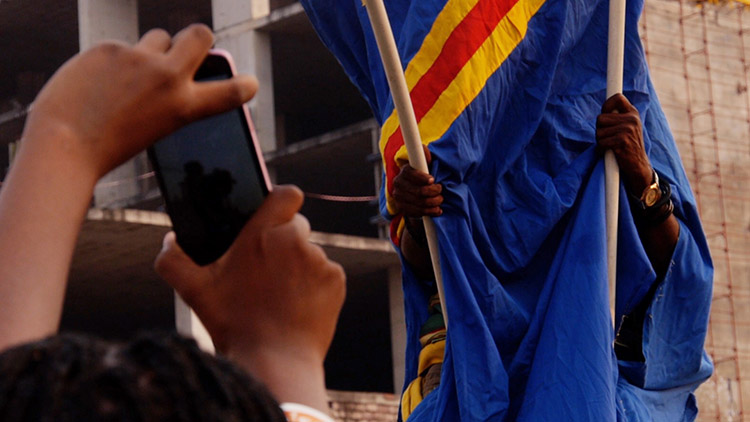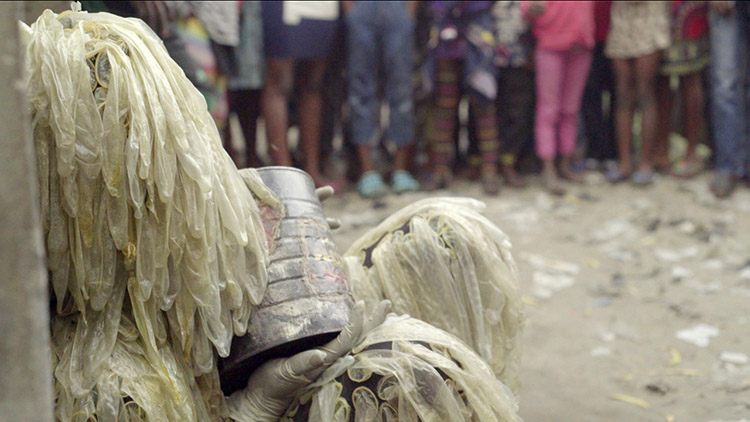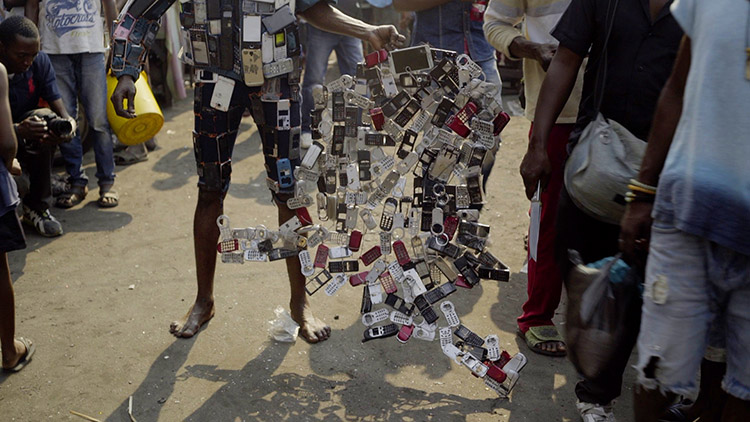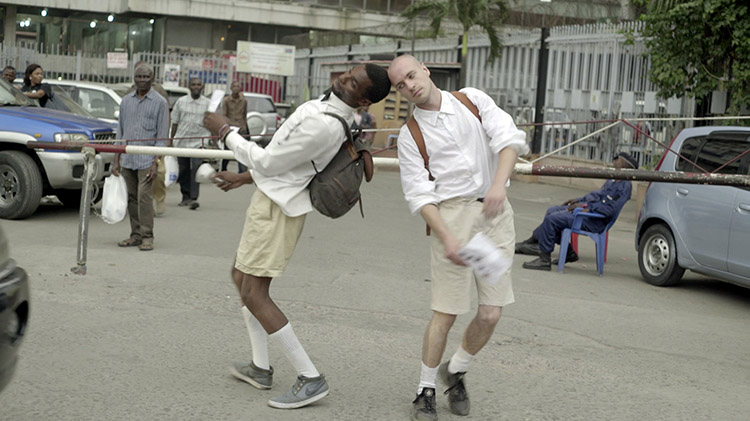Abstract
The Faire-Part collaborative documentary, launched in 2018 by directors Anne Reijniers and Rob Jacobs from Belgium, and Nizar Saleh and Paul Shemisi from Congo, aims to challenge the stereotypical portrayal of Congo as a poverty-stricken country. The documentary showcases Kinshasa’s resistance to colonial legacies and offers a more inclusive and equitable representation of the country’s culture and history by combining the four directors’ perspectives. Despite their differing backgrounds and (hi)stories, the directors engage in inner discussions on power, representation, and power dynamics, challenging their biases and perceptions. Through collaborative storytelling, they shed light on the unknown story of Kinshasa as a city of activism, using art to educate and decolonise people. This paper argues that collaborative filmmaking, as exemplified by Faire-Part, can effectively address the colonial gaze by bringing together diverse perspectives. By showcasing the power of collaborative storytelling and the importance of challenging biases, this paper aims to contribute to a more comprehensive understanding of cinema’s role in decolonisation efforts.
Keywords: Decolonising cinema, Filmmaking, Congo, Faire-Part, Collaborative Filmmaking.
Introduction
Cinema is a mass media with the power to influence public perceptions and shape social and cultural attitudes (Fearing 1947, 70). Research has shown that films construct and maintain collective understandings of identity, reinforce or challenge dominant ideologies, and shape attitudes, beliefs, and behaviours through emotional responses, cognitive processing, and social modelling (Nabi and Oliver 2009, 131-147; Adkins and Castle 2014, 1236). As such, it is essential to analyse how cinema represents cultural diversity, colonialism, and its impact on contemporary societies (Brooks and Hébert 2006, 312).
The representation of cultural diversity in cinema has been a topic of academic discussion for decades (Moreau and Peltier 2004, 125). Scholars have highlighted the lack of diverse representation in mainstream cinema, perpetuating stereotypes and ignoring the complex realities of non-Western societies. Colonialism has played a significant role in shaping the representation of cultural diversity in cinema, with colonial powers imposing their own cultural values and perceptions onto the societies they colonised (Shohat and Stam 2014, 15-37). Consequently, cinema has been used as a tool for perpetuating the colonial gaze and for portraying non-Western societies as exotic or primitive. However, in recent years, the concept of decolonising cinema has emerged, aiming to challenge dominant narratives in cinema and promote a more diverse and inclusive representation of culture and history (Shamash 2022, 52; Mistry 2021, 12).
This paper examines the concept of decolonising cinema by focusing on the documentary Faire-Part, directed by Anne Reijniers, Rob Jacobs, Nizar Saleh, and Paul Shemisi. Anne Reijniers and Rob Jacobs are from Belgium, a former colonial power that ruled Congo for over five decades. Nizar Saleh and Paul Shemisi are from Congo and have experienced the consequences of colonialism first-hand. Faire-Part is a documentary that was released in 2018. The four directors used their different perspectives to tell the story of Kinshasa, the capital of Democratic Republic of Congo (DRC), and its resistance to colonial legacies. They showcase how everyday resistance to visible and invisible traces of colonial legacies is expressed through artistic performances in the city’s many neighbourhoods. Through its depiction of street performances taking place in various parts of Kinshasa, Faire-Part explores colonial issues, such as Congo’s constant struggle against old and new colonial powers pillaging its resources, as well as the celebration of other heroes such as Patrice Emery Lumumba from the DRC’s new history as a young nation. The documentary also addresses other derived problems such as upcycling of rubbish into new resources, the role of technology, sex education, rape culture, and violence against women. In addition to its exploration of decolonisation, Faire-Part also serves as a prime example of how collaborative filmmaking can contribute to the broader understanding of global history and challenge biases. As mentioned, the four directors come from different contexts and cultural backgrounds, with varying degrees of exposure to the colonial legacy of Congo. By combining their perspectives and experiences, they were able to produce a multi-layered depiction of Kinshasa and its resistance to colonial legacies.
In short, this paper aims to provide a comprehensive overview of the concept of decolonising cinema, with a specific focus on mainstream representations of the Congo. The paper will also examine the potential of collaborative filmmaking as a means of addressing the colonial gaze in cinema, particularly in the representation of underepresented or misrepresented cultures and communities.
Decolonising Cinema
The concept of decolonising cinema was popularised by Ella Shohat and Robert Stam in their book, “Unthinking Eurocentrism: Multiculturalism and the Media” (2014). According to the authors, mainstream cinema is dominated by Western perspectives that reinforce Eurocentric values and narratives. The representation of non-Western cultures in films is often stereotypical and one-dimensional, erasing the rich histories and cultures of these communities.
Decolonising cinema involves breaking down the dominant narratives and power imbalances in the industry, promoting representation that reflects the diversity of experiences and backgrounds, and recognising the profound impact of colonialism. As hooks (1992) argues, films have the potential to challenge cultural hegemony and foster resistance, making them important tools in the decolonisation process. In order to achieve this goal, it is crucial to establish more equitable systems where cinema, filmmaking, and cultural access are available to all.
As Fanon (1963) notes, decolonisation requires creating new political and social orders that confront the legacies of colonialism. It is also critical to recognise the lasting impact of colonialism on various regions, particularly in African countries. Colonialism has far-reaching and long-lasting effects that continue to shape the social, economic, and political landscapes of many African countries, as Galtung (1998) highlights. For instance, Belgian colonialism in Congo has had devastating consequences, including environmental degradation, economic instability, and political turmoil (Mudimbe 2020, 10-50)
To decolonise cinema, it is essential to challenge the dominant narratives, diversify representation, recognise the impact of colonialism, and work towards addressing systemic inequalities. By doing so, cinema can become a powerful means for social change and empowerment. It is crucial to listen to the stories of underrepresented communities and subvert stereotypes (Hook 2012, 113).
Mainstream representation of Congo in the Cinema
The mainstream representation of Congo in cinema, has often been characterised by negative stereotypes that perpetuate a Western narrative of Africa as a monolithic and underdeveloped continent. The most common depiction of Congo has been that of a war-torn, poverty-stricken nation filled with violence and chaos. This limited perspective not only reinforces harmful stereotypes but also ignores the rich cultural heritage and complex history of the country (Callender 2013)
As noted by Nwachukwu Frank Ukadike (1994), these one-dimensional representations have been used to justify Western intervention in Congo and other African nations, while also perpetuating a sense of superiority among Western audiences. This is because these films often position Western characters or organisations as the solution to the problems faced by African nations, further reinforcing the notion that African nations are inherently unstable and unable to solve their own problems.
As argued by De Groof (2012), the limited perspectives offered by Western filmmakers have contributed to a lack of diversity and complexity in African cinema. To combat this, African filmmakers should have spaces to tell their own stories, in their own voices. This would require a shift away from a Western perspective of Africa as a monolithic and underdeveloped continent, and towards a more complex representation of the continent and its people.
In conclusion, it is crucial for filmmakers to move beyond one-dimensional depictions of Congo and to embrace the country’s multifaceted identity. This would require a shift away from negative stereotypes and a focus on the resilience, strength, and cultural richness of its people. Such an approach would not only provide a more accurate representation of the country but also challenge harmful Western narratives about Africa. Collaborative filmmaking can serve as a tool in decolonising the cinematic gaze and adopting a multi-perspectival outlook.
Collaborative Filmmaking as a Tool for Decolonising Cinema
The use of collaborative filmmaking has been suggested as a potential approach to decolonising cinema. Several scholars have explored the potential of this method, including Wiebe (2015), Carlson et al. (2017), Mistry (2021), and Fasanello and Porto (2023).
Wiebe (2015) argues that collaborative filmmaking can facilitate intercultural dialogue, co-creation of knowledge, and social action, all of which are essential to decolonisation. This is because collaborative filmmaking allows for the inclusion of multiple perspectives and encourages critical reflection on the dominant colonial narratives.
Carlson et al. (2017) proposes that film can be a powerful research tool that can translate the experiences of the invisible and make them accessible to a global audience. This can contribute to decolonisation by challenging the dominant narratives and highlighting the experiences of marginalised communities.
Mistry (2021) suggests that the decolonisation of film education can help reclaim elided histories and give visibility to marginal subjectivities. This can be achieved by incorporating diverse perspectives and encouraging critical reflection on the colonial narratives. For example, film education programs that incorporate films by women, indigenous filmmakers, and filmmakers from the Global South can provide students with a more diverse understanding of cinema.
Fasanello and Porto (2023) highlights the complexities of colonial collaboration and co-production in cinema, which are important considerations in decolonising cinema. Collaborations between filmmakers from the Global North and Global South can often result in the perpetuation of colonial power dynamics.
Overall, co-created filmmaking can contribute to decolonising cinema by challenging dominant colonial narratives, facilitating intercultural dialogue, and creating new knowledge that is inclusive of diverse perspectives. However, it is important to be aware of the potential power dynamics in collaborations between filmmakers from different cultural backgrounds.
The Faire-Part Case Study
This paragraph will present the outcomes of my content analysis of “Faire-Part.” The investigation involved an analysis of the film’s primary segments and the thematic motifs used to decolonise the narration on Kinshasa.
The documentary primarily focuses on two main aspects. The first aspect is the filmmakers’ reflections and discussions during the creative process and the second aspect is the footage of activists in the streets of Kinshasa, showcasing the resilience to mainstream narratives about their country.
Director’s reflections are part of the documentary
The documentary itself is a documentation of the filmmaking process, showcasing how directors engage in a meticulous thought process prior to every scene. Through the documentary, viewers witness directors reflecting on various aspects of their craft, such as the use of voice-over, the use of their resources, the concept of beautiful, the concept of relevance. Additionally, viewers observe the directors’ deliberations on technical aspects, such as camera selection and lens usage, as well as the ethical considerations that arise during the decision-making process. These deliberations highlight the complex and multidimensional nature of film direction and offer insight into the technical and ethical considerations behind the camera. Ultimately, the documentary not only provides an engaging and informative viewing experience, but also serves as a window into the behind-the-scenes process of filmmaking.

The choice of the topic: Kinshasa as a place of activists
The documentary showcases the lives of activists in their natural environment, documenting their viewpoints, actions, and achievements. By utilising footage and conducting interviews with these individuals, the film offers insight into their objectives and aspirations in reshaping the narrative of Kinshasa and Congo.
Throughout the documentary, viewers are treated to seven different performances that deliver powerful messages aimed at decolonising the global narrative surrounding Kinshasa and Congo. By conducting a thematic analysis, I have identified the key themes and messages conveyed in each scene. The subsequent section will present my findings on each of these scenes.
1. A call for freedom
The activist’s actions in the opening sequence of the film carry a powerful message that speaks to the complex dynamics of global politics and history. By washing the flags of various nations, the activist metaphorically highlights the need for these countries to clean up their past and present actions and stop exerting their influence over the African continent. The Congolese flag, which the activist picks up and runs around with, represents a call for freedom and self-determination for the Congo and its people. The activist’s message is that the exploitation and interference of external powers have been the root cause of the corruption and poverty that plague the Congo. This opening scene effectively sets the tone for the film’s exploration of the historical and ongoing impact of colonialism, imperialism, and globalisation on Africa and its people.

2. Kongo Poker
During the second main scene, activists read aloud the writings of Patrice Émery Lumumba, which were written during his imprisonment in Thysville in 1961. Lumumba’s writings shed light on the injustices faced by the Congolese people during the colonial era and their fight for independence. Activits in the scene also brought an interactive installation featuring a game of Kongo Poker. This game symbolises the ongoing struggle for control over Congo’s vast natural resources. Kongo Poker is a game that involves players competing to win valuable resources. The game mechanics are similar to a traditional game of poker, but the resources at stake are representative of Congo’s abundant natural resources such as diamonds, gold, and coltan. These resources have been heavily exploited by foreign powers, leading to a long-standing struggle for control over them. The game serves as a reminder of the ongoing exploitation of Congo’s resources and the need for greater equity and justice in their distribution.
3. Sexual health and education
The third scene features a man dressed in a shamanic outfit made entirely out of condoms, performing in front of a group of young people. The objective of the performance is to raise awareness about safe sex practices and the importance of promoting condom use. The man’s unique costume serves as a powerful visual metaphor, illustrating the crucial role that condoms play in promoting safe sex. The scene highlights the importance of addressing issues related to sexual health and education, and advocates for the need to break down taboos and misconceptions around the topic.

4. Women need to feel safe
The scene portrays a woman performing in a public space, who is attacked by an individual impersonating the devil of violence, symbolising a violent man. Despite the difficult situation, the woman manages to escape and captures the attacker, using her voice to declare the importance of women’s freedom from male control. This scene emphasises the resilience of women and underscores the ongoing problem of violence against women. It highlights the need for a society where women can feel safe and respected, free from the threat of violence and oppression.
5. The exploitation of Congo resources
The 5th scene portrays an activist who is dressed in a suit adorned with an array of cellphones. In addition to this, the activist is holding a remarkable cellphone construction, which is crafted in the shape of the Congo. The performance aims to draw attention to the fact that the Congo is a country that is rich in natural resources, including coltan, which is used to manufacture many of the world’s cellphones.
The use of the cellphones on the activist’s suit and the cellphone construction serves as a visual representation of the importance of the Congo in the global economy. The activist’s intention is to highlight how the Congo is often exploited for its resources, which are then used to benefit wealthier nations, without proper compensation or recognition being given to the people and communities of the Congo who are most affected by this extraction.

6. Fighting together for decolonisation
Two of the directors of the documentary, one from Congo and the other from Belgium, read and translate passages about Lumumba. Close to them there is a large artificial tooth. This tooth stands as a lasting testament to Lumumba’s legacy, for when he was tragically killed, it became the sole remaining object intimately connected to his memory, gradually acquiring symbolic meaning. The directors engage in a dialogue that demonstrates a willingness to understand each other’s perspectives and histories. Finally, they come together and rotate, symbolising unity and connection. This scene emphasises the importance of cross-cultural understanding and acknowledging the legacies of colonialism.

7. Pollution in the city
The scene depicts an activist wearing a suit made of aluminum cans, walking through the streets of Kinshasa with an unconventional gait, resembling that of an alien or monster. The activist’s intention is to draw attention to the issue of pollution in the city and to urge for greater environmental protection. The clinking sound of the aluminum cans draws the attention of onlookers, who are both intrigued and perplexed by the unusual spectacle and it is a reminder of the amount of waste generated by our daily lives and the need to reduce our environmental footprint.
Conclusion
The documentary project was carried out with great attention to the dimensions of power and the risk of adopting a Eurocentric perspective on the Congolese reality. The artists were always mindful of this and constantly questioned themselves on how to show a lesser-known side of Kinshasa while being aware of why and how to do it, and to whom they wanted to communicate their work.
Their individual backgrounds influenced their respective viewpoints, which in turn impacted their decision-making throughout the production process. Each artist filmed specific scenes and sections, and the collective decision-making process was employed to determine which portions of the footage would be included in the final cut. As such, the documentary offers a new narrative on Congo, placing a noteworthy emphasis on the activism occurring on its streets. The result is a unique portrayal of the country, which offers a fresh perspective that has the potential to provide a novel lens through which to view Congo’s social and political landscape.
Four principal recommendations can be drawn from the content analysis of this documentary, and they are as follows:
Decenter Western perspectives: To decolonise cinema, it is necessary to shift away from the Western perspective that has traditionally dominated filmmaking and prioritise the perspectives of the people being represented. The documentary Faire-Part exemplifies this approach through the directors’ discussions and reflections throughout the film.
Avoid exoticising subject: When telling stories about unfamiliar people and places, it is essential to avoid stereotypical or simplistic portrayals of the cultures and individuals being represented. Instead, filmmakers should treat them with dignity and respect. The collaboration between directors from diverse cultural backgrounds in Faire-Part exemplifies this approach.
Challenge the legacy of colonialism: Decolonising cinema requires filmmakers to examine the ways in which colonialism has influenced and shaped narratives. In Faire-Part this meant exploring the historical context of Congo and showcasing experiences of resistance, as depicted through the lives of artists and activists.
Collaborate with local communities: Authentic storytelling and respectful representation can be achieved through collaboration with local communities. This involves local actors, filmmakers, and advisors in the production, as well as seeking feedback and input from the communities being represented. Faire-Part showcases the benefits of this approach through its incorporation of local perspectives and voices.
In this study, while I worked on reflexivity, which involves reflecting on one’s own biases throughout the research process (Greene 2014, 9), the influence of my own perspective as the researcher could have still led to misinterpretations or omissions of important aspects. To address this limitation in future research, my aim is to involve multiple researchers with diverse perspectives. In addition, I plan to conduct interviews not only with directors but also with viewers of the documentary. This approach will help decrease the chances of misinterpretation and provide a comprehensive understanding of the documentary’s impact, as stated by researchers Creswell and Poth (2016). Additionally, to gain a deeper understanding of the effectiveness of collaborative cinema in promoting social change, I plan to analyse at least five collaborative movies and conduct focus groups with directors and audiences from diverse backgrounds. By incorporating feedback from these groups, future research can better address potential limitations and contribute to a more nuanced understanding of collaborative cinema’s potential to challenge dominant narratives and promote inclusivity.
Final notes
The work in this article has been partially financed by the project MILE - Migrant Integration Through Locally Designed Experiences. The project is co-funded under the European Union’s Asylum, Migration and Integration Fund (AMIF-2020-AG-CALL-03).
The work in this article has been partially financed by the GreenSCENT project. This project has received funding from the European Union’s Horizon 2020 research and innovation program under grant agreement No 101036480.
The author is a member of TransMedia Catalonia, an SGR research group funded by “Secretaria d’Universitats I Recerca del Departament d’Empresa I Coneixement de la Generalitat de Catalunya” (2021SGR00077).
I thank the Faire-Part collectif for their work and for giving me access to their documentary.
Bibliography
Books
Books with one author
Fanon Frantz. 1963. The Wretched of the Earth. New York: Grove Press.
Text note: (Fanon 1963, 155-174)
Galtung, J. 1998. Tras la violencia, 3R: reconstrucción, reconciliación, resolución. Afrontando los efectos visibles e invisibles de la guerra y la violencia, Bilbao, Gernika Gogoratuz.
Text note (Galtung 1998, 29-30)
hooks bell. 1992. Black Looks: Race and Representation. Boston MA: South End Press.
Text note: (hooks 1992, 130-131)
Mudimbe, V. Y. 2020. The invention of Africa: Gnosis, philosophy, and the order of knowledge. Lulu Press, Inc.
Text note: (Mudimbe 2020, 10-50)
Ukadike, N. F. 1994 Black African Cinema, Berkeley, Los Angeles and London, University of California.
Text note: (Ukadike 1994, 20-60)
Books with two or more authors
Creswell, J. W., Poth, C. N. 2016. Qualitative inquiry and research design: Choosing among five approaches. Sage publications.
Text note: (Creswell and Poth 2016, 139 -144)
Nabi, R. L., Oliver, M. B. (Eds.). 2009. The SAGE handbook of media processes and effects. Sage.
Text note: (Nabi and Oliver 2009, 131 -147)
Shohat, E., Stam, R. 2014. Unthinking Eurocentrism: Multiculturalism and the media. Routledge.
Text note: (Shohat and Stam 2014, 15-37)
Articles in journals
Adkins, T., Castle, J. J. 2014. Moving pictures? Experimental evidence of cinematic influence on political attitudes. Social Science Quarterly, 95(5), 1230-1244.
Text note: (Adkins and Castle 2014, 1236)
Brooks, D. E., Hébert, L. P. 2006. Gender, race, and media representation. Handbook of gender and communication, 16, 297-317.
Text note: (Brooks and Hébert 2006, 312)
Carlson, E., Rowe, G., Zegeye-Gebrehiwot, T., Story, S. (2017). Decolonization through collaborative filmmaking: Sharing stories from the heart. Journal of Indigenous Social Development, 6(2).
Text note: (Carlson et al., 2017, 29)
De Groof, M. 2012. Intriguing African Storytelling: On Aristotle’s Plot by Jean-Pierre Bekolo’. Story-Telling in World Cinemas, 1, 115-34.
Text note: (De Groof 2012, 118)
Fearing, F. 1947. Influence of the Movies on Attitudes and Behavior. The ANNALS of the American Academy of Political and Social Science, 254(1), 70-79.
Text note: (Fearing 1947, 70)
Greene, M. J. 2014. On the inside looking in: Methodological insights and challenges in conducting qualitative insider research. The qualitative report, 19(29), 1-13.
Text note: (Greene 2014, 9)
Hook, G. 2012. Towards a decolonising pedagogy: Understanding Australian Indigenous studies through critical whiteness theory and film pedagogy. The Australian Journal of Indigenous Education, 41(2), 110-119.
Text note: (Hook 2012, 113)
Mistry, J. 2021. Decolonizing processes in film education. Film Education Journal, 4(1), 1-13.
Text note: (Mistry 2021, 12)
Moreau, F., Peltier, S. 2004. Cultural diversity in the movie industry: A cross-national study. Journal of Media Economics, 17(2), 123-143.
Text note: (Moreau and Peltier 2004, 125)
Shamash, S. 2022. A Decolonising Approach to Genre Cinema Studies. Film Education Journal, 5(1), 41-54.
Text note: (Shamash 2022, 52)
Wiebe, S. M. 2015. Decolonizing engagement? Creating a sense of community through collaborative filmmaking. Studies in Social Justice, 9(2), 244-257.
Text note: (Wiebe 2015, 245)
Thesis
Callender, N. 2013. Music, Cinema and the Representation of Africa. The University of Western Ontario (Canada).
Text note: (Callender 2013)
Filmography
Faire-Part. (2018). Directed by Anne Reijniers, Paul Shemisi, Nizar Saleh and Rob Jacobs. COLLECTIF Faire-Part. Majority Flemish Production. Available at: https://www.collectif-fairepart.com/fairepart-en
Text note: (Faire-Part 2018)